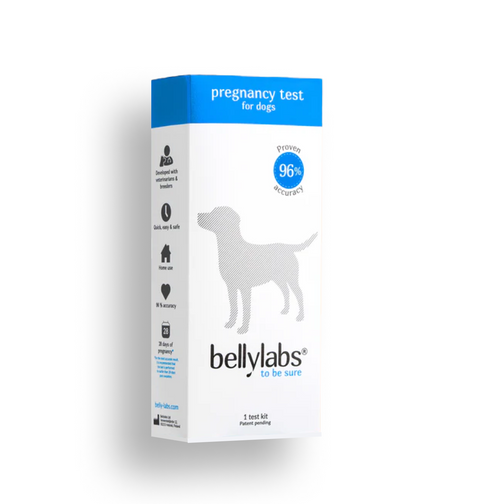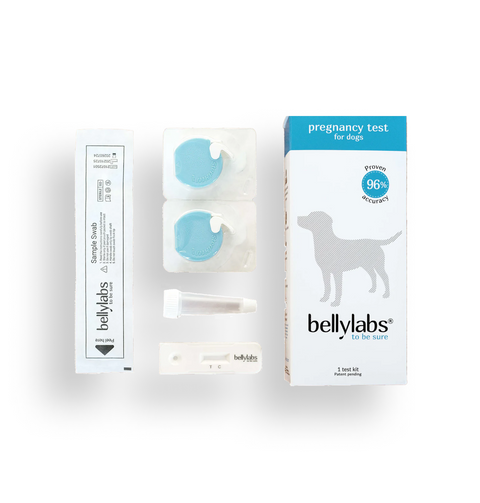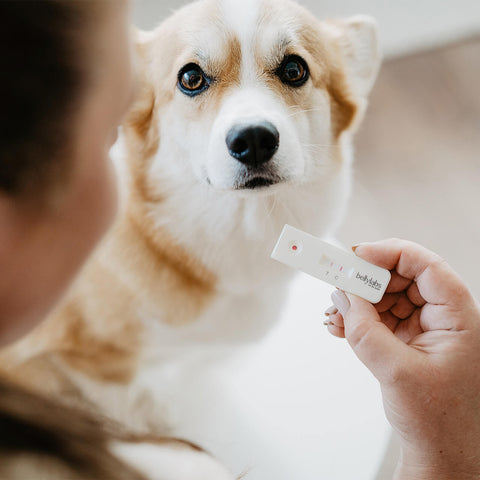Embryonic deaths are not uncommon. It is reported that in 10-11 % of pregnancies embryonic deaths happen. In pregnancies with embryonic deaths, 28.6 % of embryos are affected. It has been reported that there are more embryonic losses in pregnancies with large litters. It may even be a physiological phenomenon in such cases.
There are several known or suspected causes for embryonic death. However, it is often not easy or even possible to precisely name the cause. Chromosomal and developmental abnormalities of the embryo, inbreeding, infectious agents, maternal endocrine and uterine abnormalities, trauma, exogenous drugs, nutritional causes may be involved. In most cases with a single embryonic death the pregnancy continues normally to the end. In these cases the etiology of the embryonic death is even more uncertain.
In this article Merja Dahlbom, Doctor of Veterinary Medicine and ECAR Diplomate, explains Canine Embryonic Death.
Canine Pregnancy Loss – Embryonic Death
Pregnancy loss may occur at any stage of pregnancy. When occurring during the first half of the pregnancy it is defined as embryonic death. Canine miscarriage often goes unobserved whereas when pregnancy loss during the second half, called an abortion, visible fetuses are seen. Pregnancy loss with stillborn pups or dead fetuses are seen during and after parturition.
Early development of an embryo
After fertilization by sperm cells in the oviduct, the oocytes (now called embryos) are transported via the oviduct towards the uterine lumen. On the way the cell cleavage begins. The time from the preovulatory LH surge (luteinizing hormone surge) determines the events of embryo cleavage which are consistent among bitches. Sixteen cell stage is reached in eleven days (day 0 = day of LH peak) regardless of the day of the fertilization.
After entering the uterine lumen the embryos are at the morula or early blastocyst stage. Embryos start their transuterine migration and tend to migrate evenly in both uterine horns. Blastocysts expand and are attached to the uterine wall on day 19 - 20. At the time of 20 - 22 days the size of an embryonic vesicle (= conceptus) is 3 - 6 mm. Blastocysts are embedded in the uterine wall and the placenta starts developing on day 22 - 23. Canine placenta is composed by the fetal and the maternal part and it is endotheliochorial in structure. The circulation of these parts is separated by four layers. The type of placenta is a major factor determining the passage of immunoglobulins from the dam to the fetus. In the dog only 5 - 10 % of the immunoglobulins are transferred from the bitch’s circulation to the pups. The mature placenta forms a 2.5 - 7.5 cm wide zonary band around the uterine lumen in the middle of the oval embryonic vesicle.
Pregnancy diagnosis
There is no early pregnancy diagnostic marker in canine pregnancy. Some bitches show physical symptoms like loss of appetite in early pregnancy but these signs are not consistent and are individual.
The embryonic vesicles form a pearl-necklace like structure in the uterus and can be detected by palpation as early as 19 - 24 days after LH. In average sized dog (20 kg) the vesicles are 3 - 4 cm long on day 30 - 32, which is the easiest time for palpation. The vesicles start growing fast on days 37 - 47 and become softer in consistency and thereby more difficult to find by palpation. In large or very tense dogs or in pregnancies with a single pup situated in the cranial part of the uterus diagnosis by palpation can be challenging. The number of fetuses counted by palpation is more or less an estimate.
Ultrasonographical pregnancy diagnosis can be made at the earliest on day 19 - 20 after LH. At that time the conceptus is 1 mm in internal diameter. The growth of the conceptus follows a known course of development and different structures and organs develop at a specific time during the pregnancy. Spherical conceptus becomes elongated and causes an enlargement of the uterus. On days 23 - 24 the heart beats of the embryo can be detected. On day 30 allantoic fluid exceeds the volume of the yolk sac. Limb buds can be identified on day 34 - 35 and echogenic fetal skeleton on day 35. Colour Doppler ultrasonography allows an evaluation of the blood circulation in the conceptus and the placenta (Figure 1.).

Figure 1. Color Doppler ultrasonography showing the blood circulation of the heart of an embryo (Picture: Merja Dahlbom, Mäntsälä Veterinary Clinic)
Counting the number of conceptuses using ultrasonography especially in large litters is not easy and the number is commonly underestimated.
Radiographic evaluation of a pregnant uterus is the most reliable tool in counting the number of fetuses. A proper image of a fetal skeleton is however available not until 46 - 49 days after LH. By that time fetal bones have calcified enough to become radiopaque.
There are a few immunological and endocrinological responses to canine pregnancy. Concentrations of acute phase proteins increase as well as that of prolactin hormone starting from day 26 - 30. Neither of these is pregnancy specific; prolactin secretion starts similarly both in pregnant and nonpregnant bitches. Acute phase proteins are secreted besides pregnancy also in tissue damages or infections. Relaxin hormone is secreted only from an intact placenta and is thus the hormonal tool in pregnancy diagnosis in dogs. Relaxin secretion is detected in plasma from day 25 and reaches its peak concentration on day 50 after ovulation. The start of the secretion is concurrent with prolactin and acute phase proteins. Relaxin tests are commercially available.
Causes of embryonic death
Embryonic deaths are not uncommon. It is reported that in 10 - 11% of pregnancies embryonic deaths happen. In pregnancies with embryonic deaths, 28.6 % of embryos are affected. It has been reported that there are more embryonic losses in pregnancies with large litters. It may even be a physiological phenomenon in such cases.
There are several known or suspected causes for embryonic death. However, it is often not easy or even possible to precisely name the cause. Chromosomal and developmental abnormalities of the embryo, inbreeding, infectious agents, maternal endocrine and uterine abnormalities, trauma, exogenous drugs, nutritional causes may be involved. In most cases with a single embryonic death the pregnancy continues normally to the end. In these cases the etiology of the embryonic death is even more uncertain.
Merja Dahlbom, Doctor of Veterinary Medicine and ECAR Diplomate
Chromosomal and developmental abnormalities
Severe chromosomal aberration leads to the loss of an embryo in a very early stage. These losses cannot often be identified at all. Aged gametes may lead to abnormalities in the early development of the embryo. That is the case where mating has happened too early and sperm cells have already aged before fertilization. Also oocytes may be too old when fertilized very late in estrus. The correct timing of mating / insemination is important.
In one study it was shown that the total rate of neonates that presented malformations was 6.7 % (64/803). The most common congenital defects were cleft palate 2.8 % (23/803) and hydrocephaly 1.5 % (12/803), either alone or associated with other malformations. These malformations alone do not cause the death of an embryo but together with other malformations that also may occur.
Inbreeding
Inbreeding depression is a well-known phenomenon causing reproductive problems. High coefficient of inbreeding might predispose to problems in embryonal development. However, it has been shown not to correlate with the incidence of embryonic deaths.
Infections
Canine herpesvirus is widely spread and a common finding in dog populations. In adult dogs herpes virus infection may go unobserved or cause a mild upper respiratory tract infection. It is an important cause of neonatal death if the bitch is infected within three weeks before parturition. It’s role in early embryonic losses has not been well documented.
Canine brucellosis (Brucella canis) is the only known veneral infectious disease in dogs. The bacterium is transmitted by contact with fluids like semen, lochia (postpartum bleeding), aborted fetuses, milk. The primary clinical sign of brucellosis in a pregnant bitch is pregnancy loss which mostly (in 75 % of cases) happens in late pregnancy but may also affect early pregnancy causing embryonic death and resorption. There is a marked difference in geographical distribution of canine brucellosis in the world. Today canine semen transport is transported worldwide and testing the stud for Brucella is not only recommended but in many countries a legal requirement for getting an import license.
In the reproductive tract of both male and female dogs there are several species of bacteria forming the normal flora. Escherichia coli is the most common bacteria isolated from the healthy canine vagina. It is also the most frequently found causative organism in uterine infections like metritis and pyometra in dogs. Pyometra may occur at any stage of the estrus cycle weather the bitch is pregnant or not. Infection in the uterus does not always end up with pyometra but milder infections also occur. Pregnancy loss is a common consequence in uterine infections.
Hormones
Canine pregnancy is dependent on the progesterone hormone secreted from the ovarian corpus luteum. If the progesterone concentration falls below the critical level, embryonic death or abortion follows. There is a study showing antibodies against progesterone in bitches with low progesterone value during pregnancy, which would explain the cause of too low hormone level. Measuring progesterone in suspected cases may help to predict problems in embryonal and fetal survival.
Relaxin hormone measurement is of some help in predicting embryonic death because its concentration declines after all the placentas have already stopped functioning. However, low relaxin levels have been identified in pregnancies with several embryonic deaths in bitches with a short estrus cycle. This may indicate loss of placental integrity. After the death of a single embryo no decrease in relaxin concentration is seen.
Thyroid hormone, especially when the level is too low, has been suspected to be connected with fertility problems but its role in embryonic deaths has not been established.
Uterine abnormalities
Pathological changes in the uterine endometrium are common in dogs. This may be seen with ultrasonography as thickening and cyst-like changes of the inner layer of the uterine wall and accumulation of fluid in the uterine lumen. Affected endometrium offers a good environment for infective agents and ascending infections are common. Defective endometrium prevents maternal placenta to form or work properly which may lead to embryonic death.
Trauma
Early pregnancy is well protected against external traumas. In late pregnancy the risk is bigger and fetal losses may happen.
Exogenous drugs
Days 6 - 20 (post LH) are the most sensitive time for disturbances in embryonic development. The embryo is floating freely in the uterine lumen without placental protection. The uterine fluid has the same concentration of for example medicines as the dam’s blood. Dogs also live in a close contact with humans and are therefore exposed to same environmental chemicals. The stress caused by certain external chemicals have been shown to affect negatively the semen quality of dogs. Environmental chemicals and medicines may cause reproductive problems also in bitches including early embryonic development. Further studies are needed.
Nutrition
Nutrition plays a role in pregnancy losses only in very extreme situations. Heavy undernutrition or obesity might cause problems. However, nature is always on the side of the offspring and tries to guard the pregnancy to the very end.
Diagnosis of embryonic death
When early embryonic death is suspected there is a need for a thorough examination since clinical signs are usually absent.
Palpation of the gravid uterus often gives a suspicion of possible embryonic death. The consistency and often the size of the conceptus differ from that of a normal living embryo of that age. However, ultrasonography is needed for a precise diagnosis. It is efficient for the detection of embryonic and fetal abnormalities. Reduced diameter and abnormalities in the contour of the embryonic vesicle, no signs of viability, increased placental thickness, changes in fluid echogenity and uteroplacental arteries are seen with embryonic resorption between 2 and 4 weeks of pregnancy.
Individual conceptuses may response with asynchronous death and variable rates of resorption. It is commonly seen that some conceptuses are still alive when some of them are already dead. The final resorption of the conceptus takes 2 - 5 days (Figure 2.).

Figure 2. Early embryonic death on day 28 after ovulation. Decrease in the amount of fetal fluid and thickening of the wall of the conceptus are seen. The embryo cannot be identified. A normally developed conceptus is seen adjacent to it. (Picture: Lena Lindh, Reprovet Oy)
Today there are even more advanced techniques available for the diagnostics of embryonic deaths.
The use of contrast media enhanced ultrasonography has appeared to permit evaluation of the maternal and fetal vessels in the first two thirds of gestation. However, impending embryonic death was not predicted by changes in the perfusion of small uteroplacental vessels.
Fetal fluid collection has been successfully performed with a low risk. It may provide a deeper understanding also in the diagnostics of fetal deaths or early identification of heritable diseases.
References
Brown S. A., Fluoroquinolones in animal health. J Vet Pharmacol Ther . 1996 Feb;19(1):1-14.
Buff S, Preganancy diagnosis in the bitch and queen, in the Compendium of Third EVSSAR European Congress on Reproduction in Companion, Exotic and Laboratory Animals, Liege 2002.
England G. C. W., Russo M. Ultrasonographic characteristics of early pregnancy failure in bitches.
Theriogenology, 2006 Oct;66(6-7):1694-8.
England G., von Heimendahl A., BSAVA manual of Canine and Feline Reproduction and Neonatology, BSAVA, 2.ed. 2010.
Concannon P., Tsutsui T, Shille V. Embryo development, hormonal requirements and maternal responses during canine pregnancy. J Reprod Fertil Suppl. 2001;57:169-79.
de Freitas L. A., Mota G L , Silva H V R , Carvalho C F , da Silva L D M. Can maternal-fetal hemodynamics influence prenatal development in dogs? Anim Reprod Sci. 2016 Sep;172:83-93.
Günzel-Apel A. R. , Höftmann T, Nottorf S, Politt E, Meyer-Lindenberg A, Hoppen H O, Einspanier A, Knijn H M, Mischke R. Influence of progesterone withdrawal on pregnancy-related parameters during post-implantation early pregnancy loss. Reprod Domest Anim. 2009 Jul;44 Suppl 2:174-81.
Günzel-Apel A. R., Zabel S, Bunck C F, Dieleman S J, Einspanier A, Hoppen H O. Concentrations of progesterone, prolactin and relaxin in the luteal phase and pregnancy in normal and short-cycling German Shepherd dogs. Theriogenology. 2006 Oct;66(6-7):1431-5.
Johnston S. D., Raksil S. Fetal loss in the dog and cat. Vet Clin North Am Small Anim Pract. 1987 May;17(3):535-54.
Johnston S. D., Root Kustritz M V, Olson P N S. Canine and Feline Theriogenology, W.B.Saunders Company, 2001.
Krackhudel J., Bondzio A, Einspanier R, Einspanier A, Gottschalk J, Kuechenmeister U, Muennich A. Luteal insufficiency in bitches as a consequence of an autoimmune response against progesterone? Theriogenology. Jun;79(9):1278-83.2013.
Lea R. G., Byers A S, Sumner R N, Rhind S M, Zhang Z, Freeman S L, Moxon R, Richarson H M, Green M, Craigon J, England G C W. Environmental chemicals impact dog semen quality in vitro and may be associated with a temporal decline in sperm motility and increased cryptorchidism. Scientific Reports 6, Article number: 31281, 2016.
Miranda S., Carolino N , Vilhena H, Payan-Carreira R, Pereira R M L N. Early embryo development, number, quality, and location and the relationship with plasma progesterone in dogs. Animal Reprod Sci. Nov;198-245, 2018.
Orlandi R., Vallesi E, Boiti C , Polisca A , Troisi A , Righi C, Bargellini P. Contrast-enhanced ultrasonography of maternal and fetal blood flows in pregnant b itches. Theriogenology 2019 Feb;125:129-134.
Pereira K. H. N. P., Correia L E C D S, Oliveira E L R, Bernardo R B , Jorge M L N , Gobato M L M , de Souza F F , Roch N S , Chiacchio S B, Lourenço M L G. Incidence of congenital malformations and impact on the mortality of neonatal canines. Theriogenology. 2019 Dec;140:52-57.
Tal S., Bar-Gal G K , Arlt S P. Evaluation of short-term safety of ultrasound-guided foetal fluid sampling in the dog (Canis lupus familiaris). Vet Rec. Apr;188(7), 2021.












